How to Clean a Nescafe Dolce Gusto Coffee Machine?

We’re glad to hear that a Nescafé Dolce Gusto appliance has found a place in your home too! Or perhaps you’re planning on purchasing a Nescafé Dolce Gusto coffee machine and are looking for some information about the maintenance it’s going to require?
To help your machine serve you for years to come, letting you enjoy delicious drinks brewed with close to no effort, we’ve decided to discuss the key features characterising the maintenance of Nescafé Dolce Gusto appliances. A clean, well-maintained machine will not only brew excellent coffee, but it’ll also stay part of your morning ritual for much longer than it otherwise would.
Cleaning a Nescafé Dolce Gusto Coffee Machine
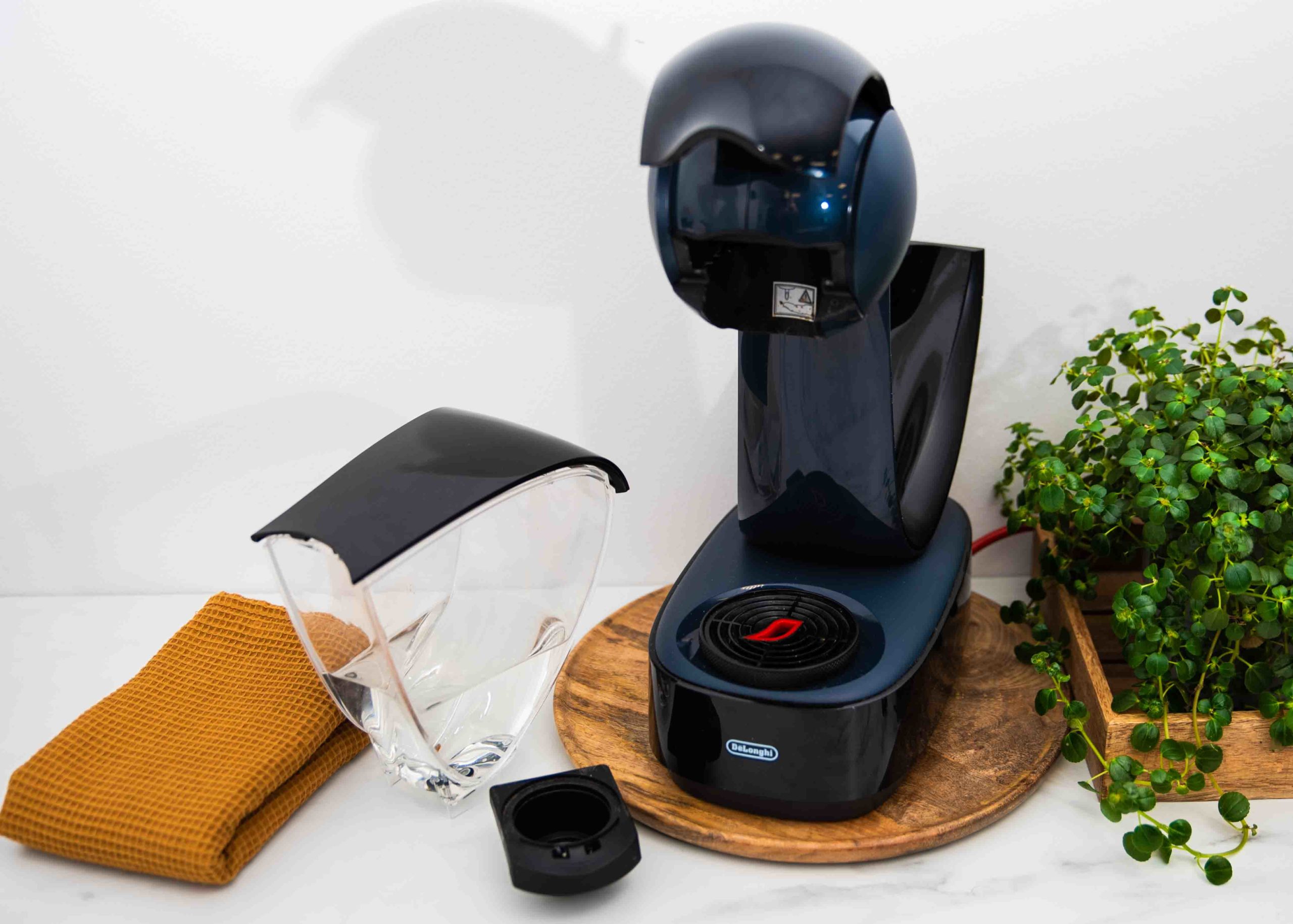
All of us want to enjoy delicious coffee each time we decide to brew a cup, yet this is impossible without a clean, well-maintained coffee machine. After all, the beverage is affected not only by the capsules we use or the features of our coffee machine, but also by how hygienic this appliance is. There’s a saying floating around in coffee connoisseur circles: “If you want to get an idea of the flavour of the drink you’re preparing without so much as taking a sip, just assess the cleanliness of the machine that’s been used to brew it.” Drinking coffee brewed in a clean appliance is much more pleasant! Moreover, a well-maintained coffee machine is capable of unveiling the real flavour of your coffee, unaffected by old coffee residue, while also ensuring that the beverage you’ve prepared is equally as delicious and fragrant every single time.
When it comes to cleaning procedures, they can be divided into two separate stages: these are internal cleaning and external cleaning. The first stage includes cleaning the appliance’s drip tray, capsule holder, water tank and body. These procedures should be performed regularly, every few days.
External Cleaning
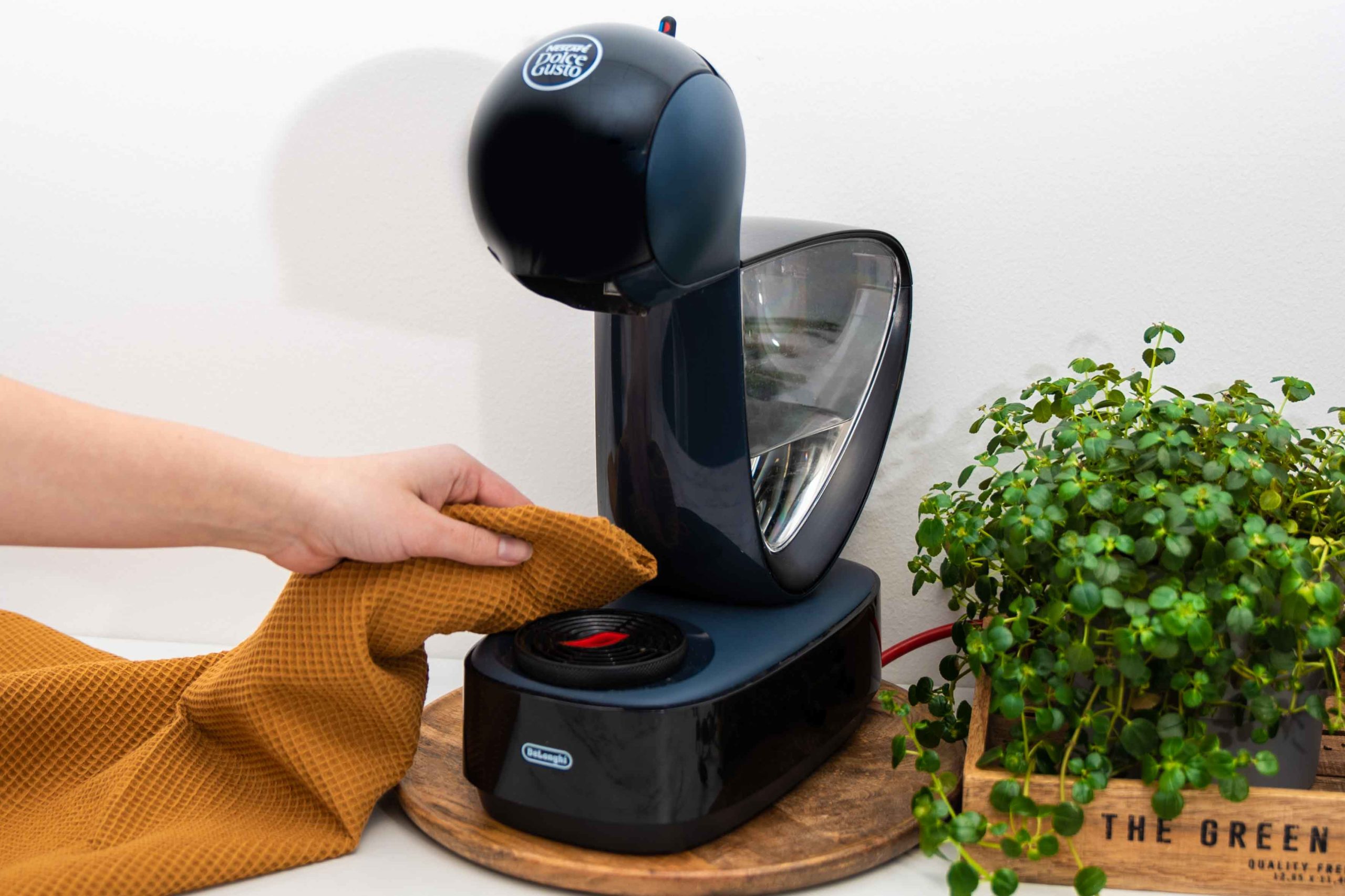
Drip tray. This is undoubtedly the messiest component of any coffee machine — and that’s perfectly normal because all of the drink residue is supposed to accumulate inside the drip tray. Although this tray isn’t directly involved in the brewing process, washing any coffee residue or impurities off it is still important in terms of general hygiene. Keep in mind though that drip trays and their grates are rarely dishwasher-safe, so only wash them in the dishwasher if the user manual of your chosen model indicates this can be done.
Capsule holder. Another crucial component of your Nescafé Dolce Gusto coffee machine is its capsule holder. It must be rinsed regularly from both sides so as to prevent old coffee residue, dust or various other impurities from accumulating inside it. If you’re always short on time, you’re in luck: these capsule holders are dishwasher-safe!
Water tank. Don’t forget the water tank of your machine too! As much as 98% of your morning coffee is made up of water, so a well-maintained water tank is definitely synonymous with delicious drinks. Clean, colourless and odourless water must be used when brewing coffee, which is why regular maintenance is so important in this case. Make sure to empty and rinse the water tank every few days: the water in the tank should be as fresh as possible. It’s also crucial to protect the tank from limescale or any external impurities. Sadly, you won’t be able to wash it in a dishwasher.
Body. The last step of external maintenance involves cleaning the body of your machine. Nowadays, a coffee machine is more than just a regular household appliance: more often than not, it’s also a stylish interior accent that’s crucial to the look of a certain corner of your house. A spotless, shiny machine is guaranteed to serve this purpose well. All you need to do is clean its surface with a soft, wet cloth and then dry it with a dry kitchen towel.
Internal Cleaning
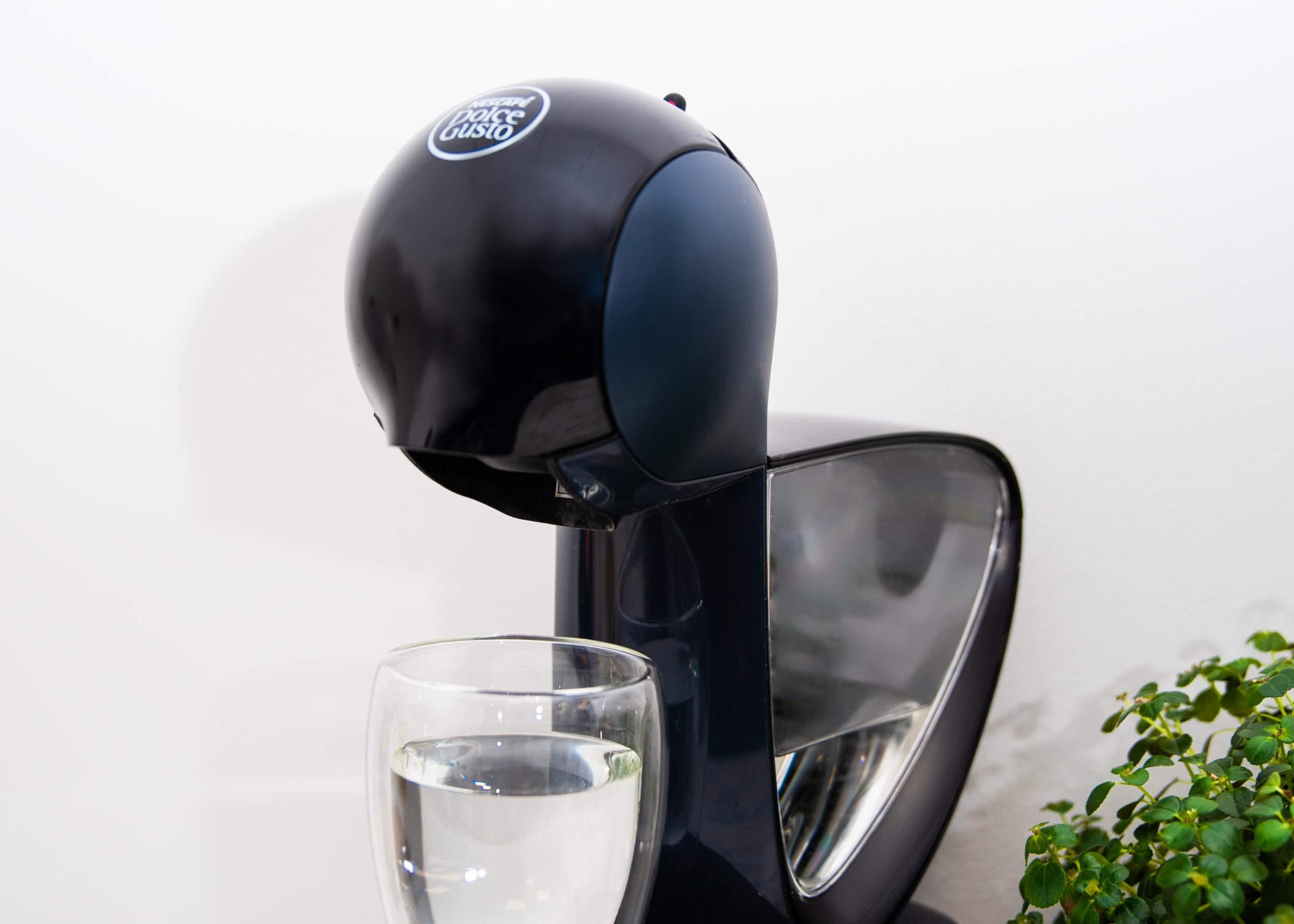
To enjoy delicious coffee day in and day out, you’ll also have to ensure internal hygiene of your appliance. Thankfully, this can be done with ease: simply run the rinsing program to get rid of fine coffee particles or impurities accumulated within the machine’s internal system. Sure, this won’t affect limescale deposits, but you’ll learn all about how to descale your coffee machine a bit later on. When it comes to rinsing it though, all you’ll have to do is dispense a serving of hot water.
Cleaning Procedure From Start to Finish
We can sum up the whole cleaning process and divide it into several clear steps, which, if performed every couple of days, will help your Nescafé Dolce Gusto coffee machine serve you for years to come.
- Clean the drip tray with a soft brush and then dry it with a clean cloth. The drip trays of some models are dishwasher-safe, but make sure to check before putting yours in a dishwasher.
- Rinse the capsule holder from both sides and dry it. This component is dishwasher-safe.
- Clean the water tank with a soft, clean, food-safe brush, then rinse the tank and dry it with a clean cloth. Fill the water tank with fresh drinking water and put it back into the machine. The tank is not dishwasher-safe.
- Use a soft, damp cloth to clean the head of the machine around the piercing needle.
- Open the locking handle and insert an empty capsule holder into the machine. Close the locking handle, then place an empty container under the coffee outlet.
- Turn on the appliance and wait for it to warm up. Once it does that, move the selection lever to the hot water position in order to start rinsing.
- After around 30–60 seconds, return the selector to the neutral position. If your model’s equipped with the option of automatic beverage volume control (the desired volume can be selected on the volume display), set the bar display to the maximum level and press the brewing button. Once the system’s been rinsed, empty the container and dry it with a clean cloth.
- Turn off and unplug the machine. Clean its exterior with a soft, damp cloth and then dry it.
These simple steps will be enough to help you maintain the cleanliness of your capsule coffee machine and enjoy exquisite coffee drinks every single day.
How to Clean the Injector of Your Nescafé Dolce Gusto Coffee Machine?
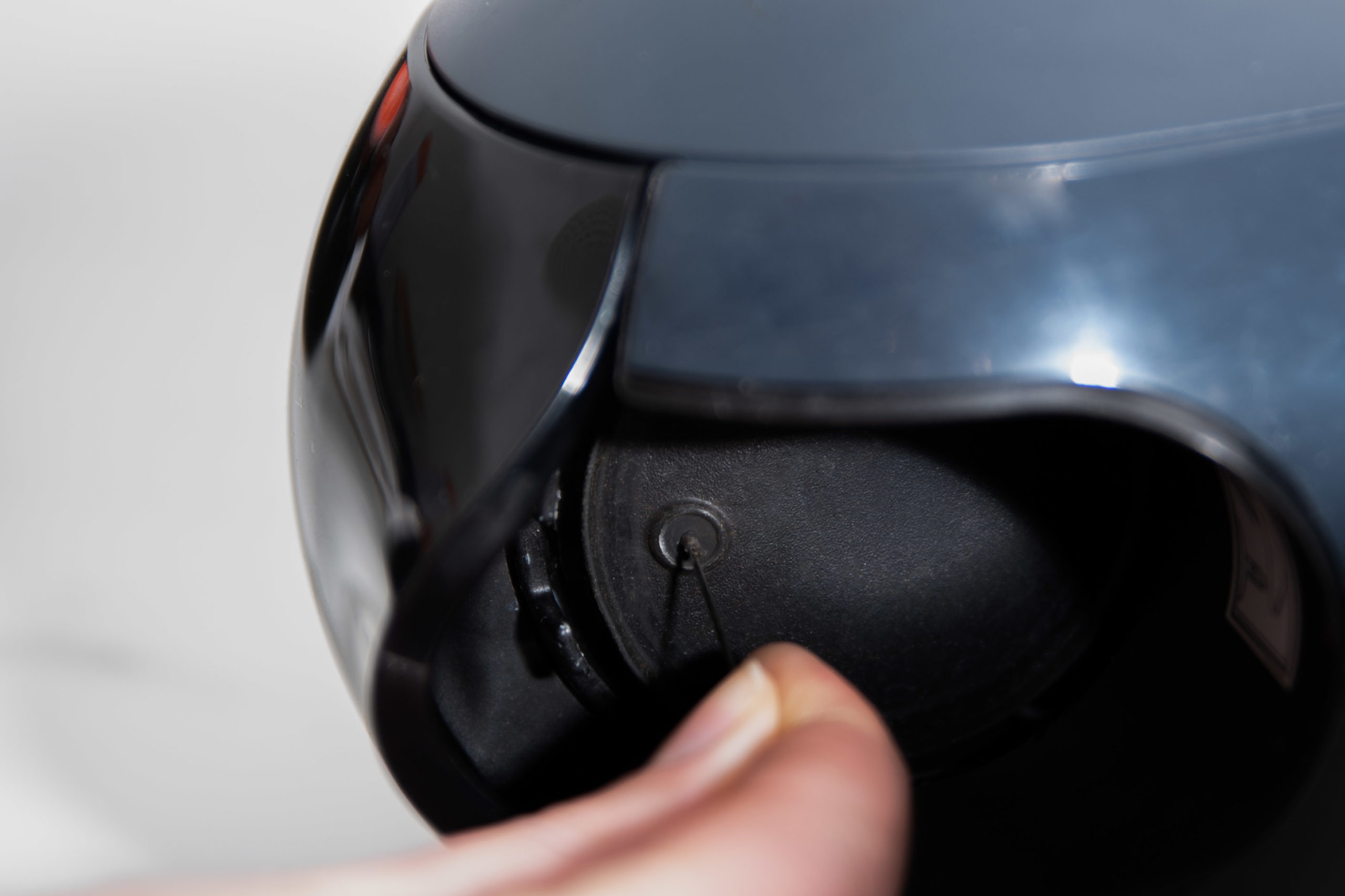
All of us forget to clean our coffee machine sometimes — and even if it’s maintained to absolute perfection, your coffee may still start dribbling instead of flowing into your cup freely. It’s as if water has trouble seeping through the ground coffee particles. If this happens to you, check if the injector of your capsule coffee machine isn’t blocked. Once the needle pierces the capsule, water begins flowing through it. Dolce Gusto coffee machines are equipped with an excellent coffee injector that guides coffee straight into your cup.
Every time you brew a cup, coffee flows through the injector, so it’s only natural for a decent amount of residue to accumulate on the injector’s walls. If the injector becomes blocked, coffee is dispensed using lower pressure and the resulting serving is smaller than usual. Luckily, the manufacturers of your Dolce Gusto have anticipated this problem and included a small cleaning needle with a spiral on one end in the set of your coffee machine. This needle is designed specifically for the cleaning of the injector and can be found either behind the water tank or inside its tray — the user manual of your coffee machine contains its exact location.
Cleaning Steps
- Open the locking handle and remove the capsule holder.
- Throw out the used capsule (if there is one).
- Find the cleaning needle and close the locking handle.
- Unplug the machine and tilt it slightly so that you can see the injector.
- Clean the injector with the cleaning needle.
Descaling a Nescafé Dolce Gusto Coffee Machine
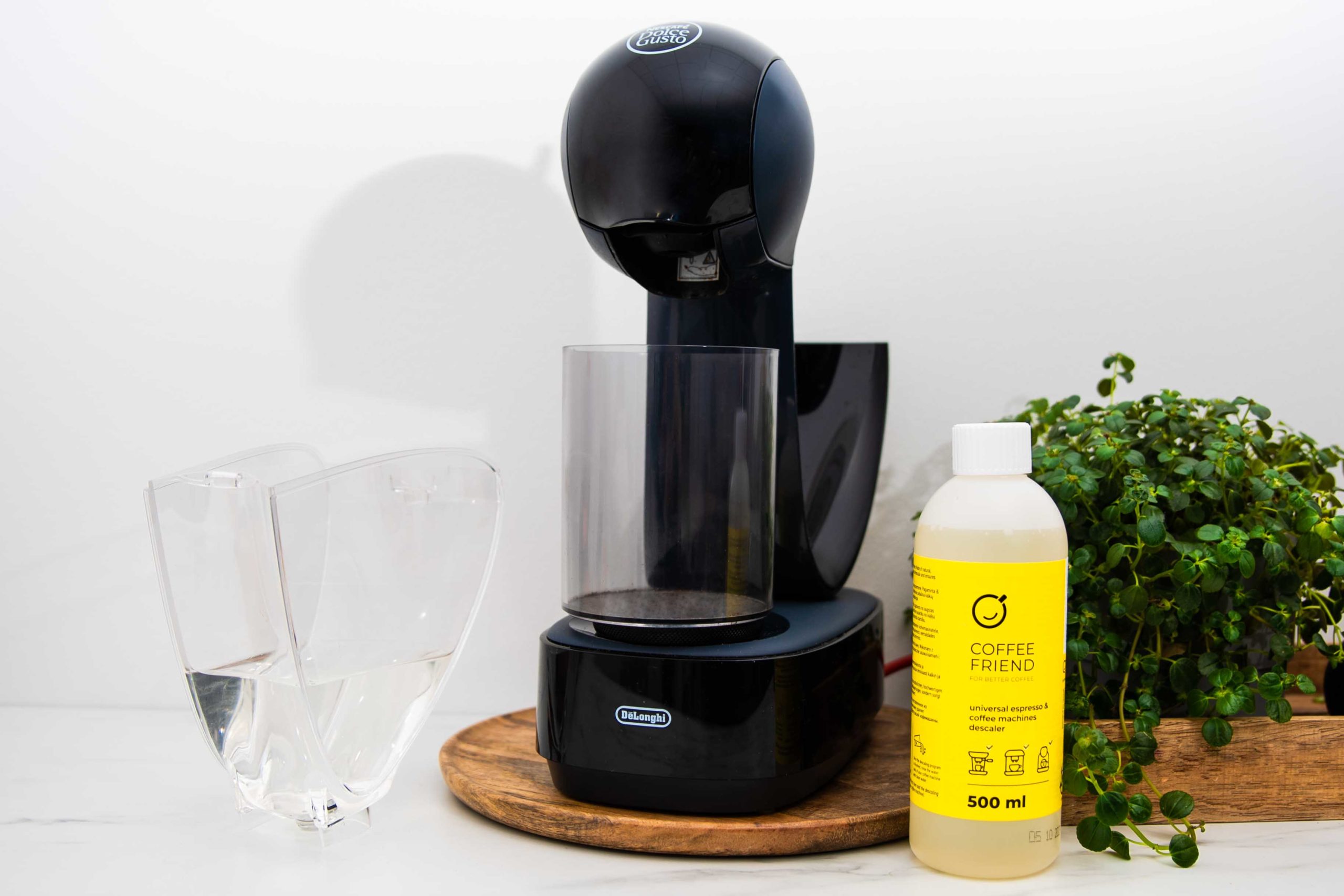
It’s said that when it comes to any appliance that uses hot water, limescale is its arch-enemy. No wonder then that limescale is one of the key reasons behind various coffee machine malfunctions too — and that these malfunctions can even render some machines completely unfixable. Limescale actually results from hard water being heated: water like that contains lots of calcium and magnesium bicarbonates, which are converted into water, carbon dioxide and insoluble carbonates as temperature increases. The latter ultimately form deposits on the walls of the heating element and clog up the water system. Once that happens, the process of brewing a cup of coffee starts taking longer. Consequently, more energy is consumed and the costs involved in keeping your machine running inevitably increase.
Limescale deposits affect the flavour of your coffee too: as pressure within the system drops, some qualities of your coffee can’t be revealed, while the overabundance of ions found in hard water may result in poor taste due to increased solubility of various undesirable substances.
When Should You Descale Your Nescafé Dolce Gusto Coffee Machine?
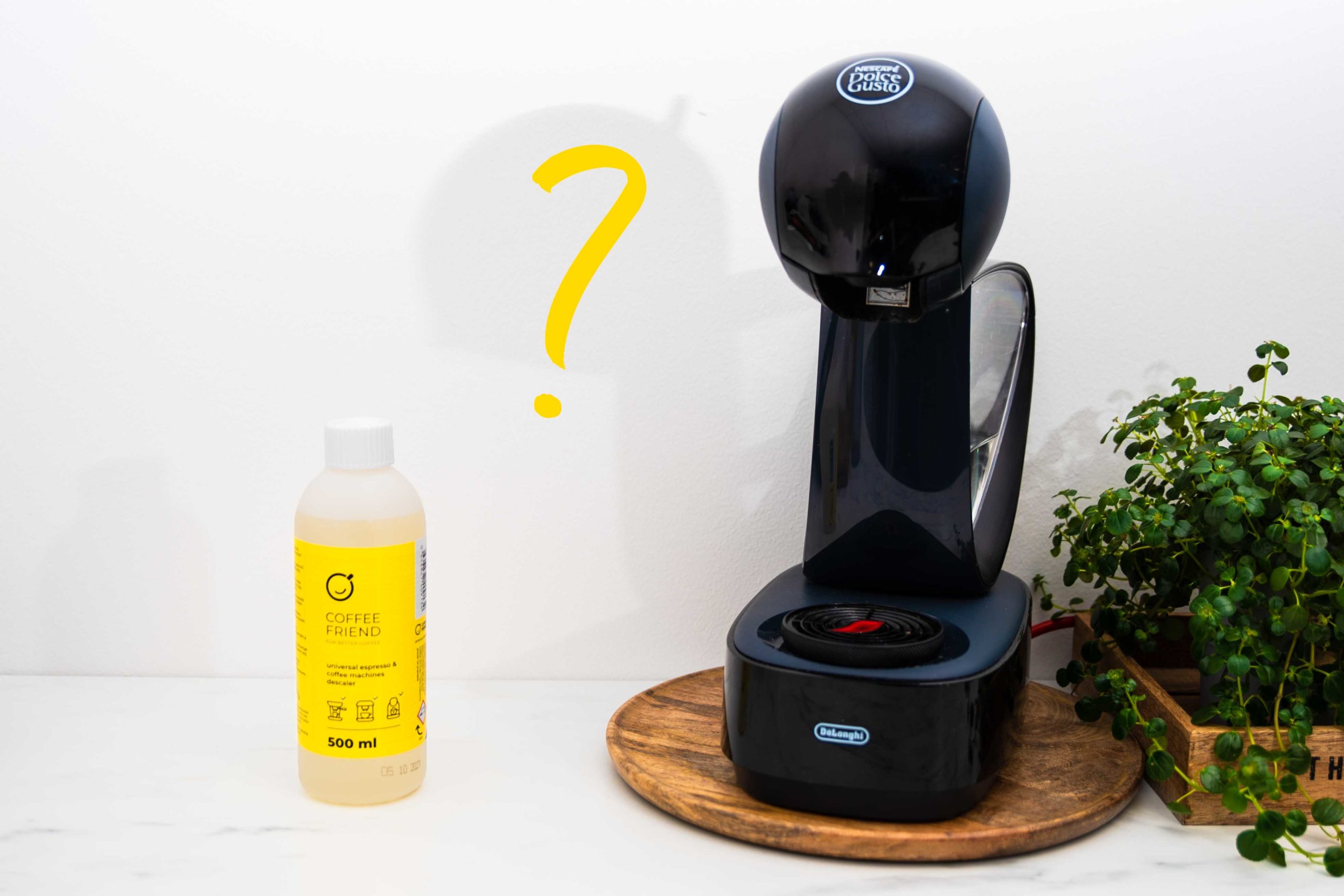
Because of the reasons discussed above, regular descaling of your coffee machine is an absolute necessity. You might be wondering though just how often you’re supposed to do it. Unlike appliances manufactured by other brands, older models from Nescafé Dolce Gusto weren’t capable of notifying their users about the need to descale them. However, models produced over the past few years can now boast this feature: when it’s time to descale the machine, you’re notified with the help of a special message or the ON/OFF button lighting up yellow/orange. There are other important factors signifying the need to descale your coffee machine as soon as possible, for example:
- the temperature of your coffee being lower than it normally is;
- changes in the flavour of coffee even when it’s brewed using the same capsules;
- small volume of coffee dispensed or no coffee dispensed at all.
If you detect these or similar signs of blockage, descale your machine immediately. If you haven’t detected any of them and your coffee machine isn’t capable of notifying you about the need to descale it, you should perform the descaling procedure at least once every 3 months.
All coffee machines are descaled in a similar fashion: first, some descaler is poured or a descaling tablet is dropped into the water tank and the required amount of water is added. During the procedure, this mixture of water and a special descaling product fills up the water system until, finally, the solution is dispensed from the coffee spout in certain intervals. Once the entire solution has been dispensed, you must rinse the water tank thoroughly, fill it up with clean water and rinse the water system one more time.
What Kind of Descalers Are Best Suited to Nescafé Dolce Gusto Coffee Machines?
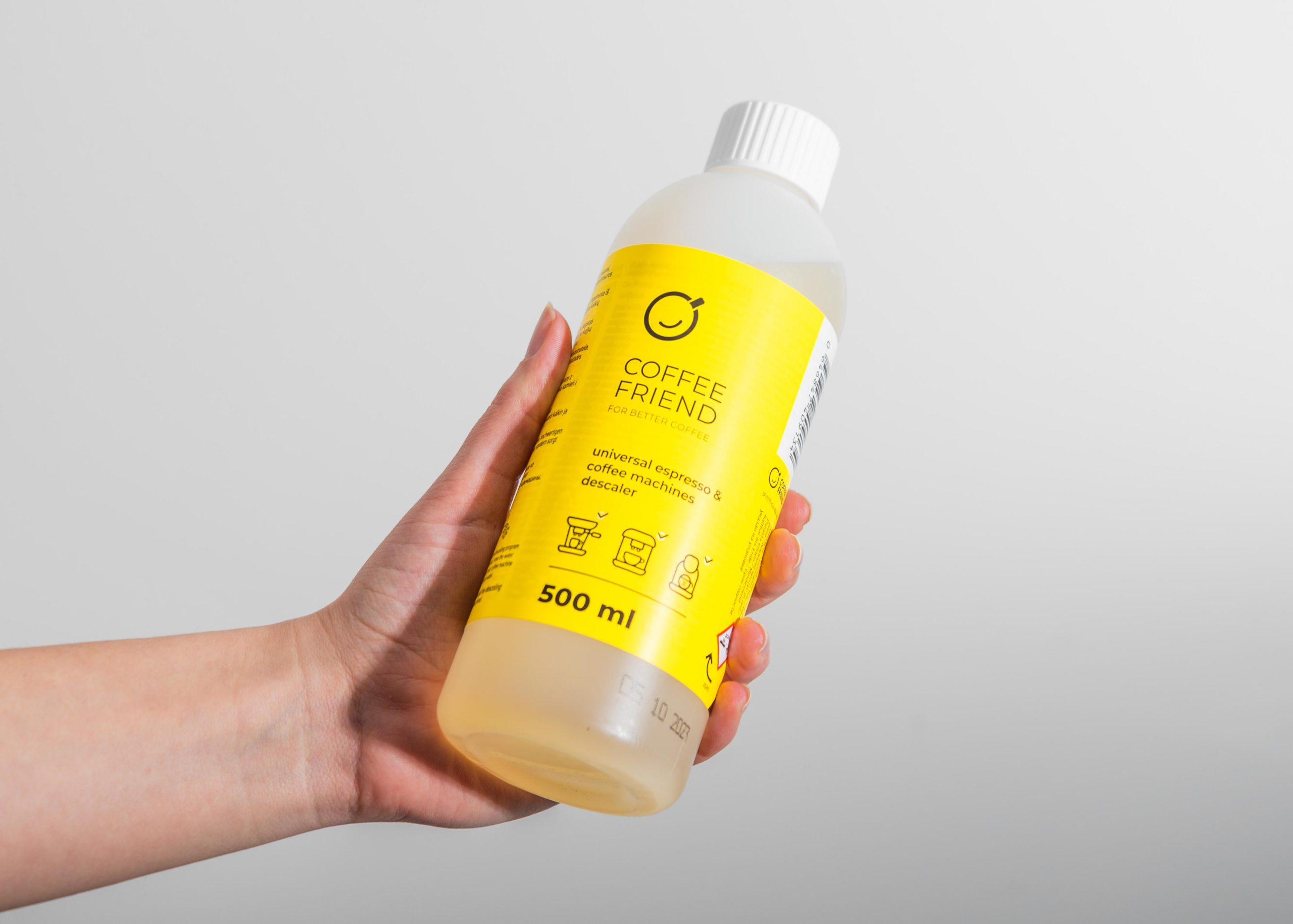
If asked about products that may help you descale your coffee machine, the first thing to pop into your head might be citric or acetic acid. It’s often used to remove limescale deposits from kettles or other household appliances, and it’s good at its job too. When it comes to descaling coffee machines though, using citric or acetic acid is not recommended. Why that is, you wonder?
Well, to remove limescale over the duration of a standard descaling procedure, the right concentration is needed. If your descaling solution isn’t strong enough, it may not be able to remove all of the limescale built up inside the appliance. If, on the contrary, the solution’s too strong, it can end up damaging your coffee machine. Acid is particularly harmful to rubber gaskets — and if they don’t do their job, your machine is bound to start leaking.
That’s why we suggest using descalers designed specifically for coffee machines and adapted to their unique requirements. Products like that remove limescale with extreme efficiency, and they do that over the course of a standard coffee machine descaling procedure. The universal coffee machine descaler “For Better Coffee” is a great choice, suited perfectly for all Nescafé Dolce Gusto coffee machines.
How to Descale a Nescafé Dolce Gusto Coffee Machine?
Your coffee machine should be descaled at least once every 3–4 months. Most Nescafé Dolce Gusto models are equipped with an integrated descaling program — if your machine has one, refer to the user manual to learn how to run it. The majority of models are descaled in a similar way though: all you have to do is press and hold the ON/OFF button when the appliance is switched off (the latest models feature a separate descaling button). Below, you’ll find some general steps that’ll help you get an idea of how you should go about descaling your coffee machine.
If your model’s equipped with an integrated descaling program, follow these steps:
- If your machine isn’t equipped with a separate descaling button (Jovia, Infinissima, Mini Me, Genio 2, Eclipse and some Piccolo models), switch off the appliance using the ON/OFF button, but make sure not to unplug it. If your machine has a descaling indicator (Genio S models), there’s no need to switch it off.
- If there’s water left in the water tank, empty it. Mix your descaler with water using a ratio of 1:10 (e.g. if you need to use 500 ml of water, mix it with 50 ml of descaler), then pour this solution into the empty water tank and put it back into the machine.
- Open the locking handle and insert the capsule holder with the rinsing tool (if it was included in the set of your model) into the machine. Close the locking handle. Place a container with a capacity of at least 1 l under the coffee outlet.
- If your machine is equipped with a volume display, select the maximum level.
- If your machine isn’t equipped with a separate descaling button, press the ON/OFF button and hold it for at least 5 seconds (the coffee machine must be switched off at this time). If it does have a descaling indicator, proceed to this step: in the Genio S version with a dial, select the “XL” option, then turn the dial clockwise four times; in the Genio S Touch version, press and hold the descaling indicator for at least 5 seconds. The ON/OFF button or the descaling indicator will then start flashing orange and the machine will switch to the descaling mode.
- If your machine has a selection lever, move it to the hot water position. If it doesn’t have a lever, press the coffee button.
- If your machine isn’t equipped with a volume display, wait until about half of the descaling solution has been dispensed from the water tank and then return the lever to the neutral position. Models with a volume display stop the procedure all by themselves.
- Wait for around 2 minutes for the descaling solution to stop working.
- Rinse the water tank, fill it up with fresh, clean water and put it back into the machine.
- If your machine is equipped with a lever, move it to the hot water position. If your model doesn’t stop the procedure automatically, return the lever to the neutral position once half of the water has been dispensed from the tank (unless the user manual suggests otherwise). If your machine does stop the descaling procedure by itself, wait for the lever to return to the neutral position. Then move the lever to the left (towards the cold water selection) and return it to the neutral position once the water tank is completely empty (or wait for the lever to go back by itself).
- If your machine isn’t equipped with a lever, press the coffee button.
- Once the descaling procedure has been completed, switch off your coffee machine. Open the locking handle, remove the capsule holder and the rinsing tool (if it was included in the set), then rinse and dry them. Keep the rinsing tool in a safe place for later use.
- Fill the water tank with fresh, clean water.
There are some Dolce Gusto models without an automatic descaling program out there. If that’s true for your coffee machine, you can still follow the same basic principle we’ve described above: dispense the descaler over a couple of portions while switching the lever from hot to cold, then rinse the system with fresh water.
Watch Videos on How to Descale the Most Popular Models
We’re definitely aware of the fact that descaling procedures differ from model to model and it’s certainly easy to get lost amongst their varying features. That’s why we’ve decided to film some videos detailing the descaling procedures of the most popular Nescafé Dolce Gusto models. If you have a different model, yet it’s operated in the same way, this information will apply to your machine too.
Nescafe Dolce Gusto Genio S descaling
Nescafe Dolce Gusto Genio S Plus descaling
Nescafe Dolce Gusto Genio S Touch descaling
In Conclusion
So, there it is: these are all of the procedures you’ll have to perform if you want your coffee machine to serve you for as long as possible. Cleanliness, hygiene and regular descaling will help you avoid malfunctions and have the true flavours of your coffee extracted to the fullest. We hope these maintenance tips will help you enjoy exquisite beverages day in and day out!
If you have any questions, don’t hesitate to reach out to us: we’ll be happy to provide you with more advice related to the use and maintenance of your coffee machine.
